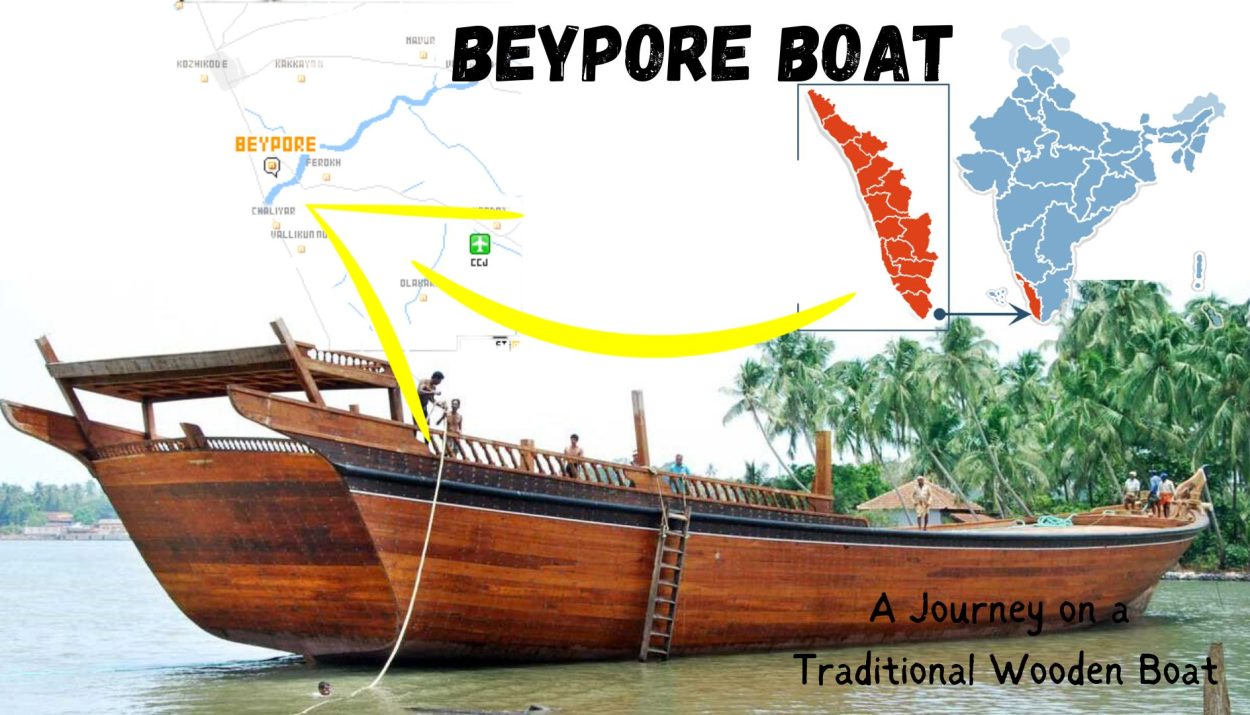Beypore is an ancient port town about 10 km from the district of Kozhikode in the Indian state of Kerala. Local people and craftsmen here make ships out of wood. These boats have a rich history and cultural significance and are an integral part of the local fishing communities in the region. Beypore has been a centre of excellence for boat-making for hundreds of years. The availability of good craftsmen and timber made it a popular shipbuilding centre. It is a tedious laborious process. It took years to get a ship ready to sail.
Beypore boats are known for their distinctive shape and design, which have been perfected over centuries of use. They are characterized by their large size and strong build and are capable of navigating the rough and choppy waters of the Arabian Sea.
These big boats are locally called “Uru”. Uru was originally an Arab dhow, a traditional sailing vessel mostly used by Arabs for trade. Dhows are popular along the Arabian coast. There were very strong trade links between Arabia and the southwest coast of India in ancient times. These Urus made in Beypore go towards the Arabian coast. Most of the wooden Urus go with minimal interior work and the rest of them are completed in Arabia.
The craftsmanship of the workers here is exceptional. Uru-making is an undocumented process, unlike modern-day shipbuilding. Everything is designed with shipbuilders in mind who work as a team to bring highly intricate woodwork to perfection.
Khalasis or Mappila Khalasis, highly skilled labourers of Malabar play a major role in making Uru.
Techniques for Uru-making
There are no sketches, drawings, blueprints or prototypes. It’s all in the craftsmen’s heads.
The hull of the vessel is usually brought into the water before the upper body is built. Hull has to be as flat as possible. The construction of the entire ship is completed on the shore and only the finished product touches the water by the Khalasis with the help of an ancient pulley wheel mechanism.
Modern ships are much smoother and their stability is controlled by multiple gyro systems and mechanical devices. But in the Beypore boat, the shape itself has to be stable so a wide bottom is preferred. To make it leakproof, they use cotton wicks at the joint with the help of a hammer and chisel (the process is known as caulking). Aluminum is used to make cabins because it is very light and can be easily fabricated.
Uses of Beypore Uru
The Urus manufactured here is in great demand among traders in the Middle East. Urus is basically used for sea travel hence transporting people or goods.
In addition to being used for fishing, the Beypore boats have also played an important role in the local economy, as they have been used for transportation, commerce, and even military purposes in the past. They are an important part of the cultural heritage of the region and have been passed down from generation to generation.
A look at Today’s situation
This traditional wooden boat still exists in different parts of India. It is a position of prestige and honour for the sheikhs of Arabia to own a large dhow made of wood. Today there are a few Uru manufacturing centres in Beypore that still make wooden ships. These wooden Urus are eco-friendly, long-lasting and easy to maintain. Most of the material can be reused and recycled.
Although traditional Beypore boats have gone out of fashion in India, boatmakers still receive occasional orders from the Arabian Gulf where dhows are still in use. The knowledge of making Urus has been developed and passed down orally over hundreds of years.
In recent years, the traditional art of building Beypore boats has come under threat due to a decline in demand for these vessels. This is largely due to the increasing use of modern boats and equipment, which are seen as more efficient and profitable.
To preserve this important cultural and historical tradition, efforts have been made to revive the Beypore boat-building industry. This includes efforts to promote the traditional method of building these boats as well as provide training and support to local boat-building communities.
Conclusion
The Beypore boat is a unique and important part of the cultural heritage of the southwestern coast of India, and a symbol of the region’s rich history and traditions. Efforts are being made to preserve and promote this traditional craft, and to ensure that future generations are able to experience and appreciate the beauty and significance of the Beypore boat.
Recently, District Tourism Promotion Council, Kozhikode applied for a Geographical Indication tag for the Beypore boat.
We hope you found this information to be both fascinating and enjoyable. Thank you for taking the time to read it.
References
Geographical Indication tag sought for Beypore Uru
Beypore boat to figure in project report for Swadesh Darshan project

1 Comment
The Legacy of Beypore, Kozhikode – pinklungi.com
7 months ago[…] historically trading with the Middle East. It was well noted for building wooden ships, known as urus in Malayalam. Arab merchants originally used these ships for trading and fishing, but now they serve as tourist […]